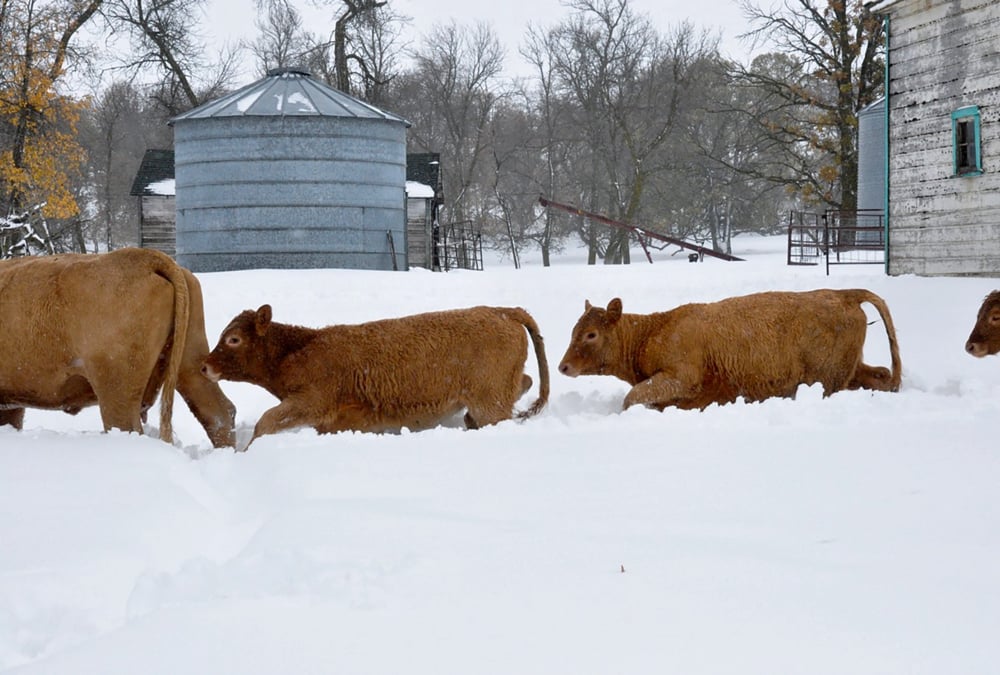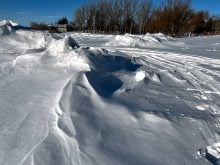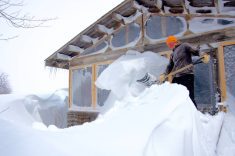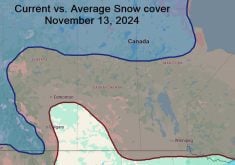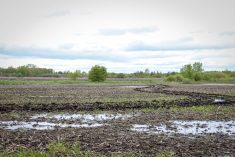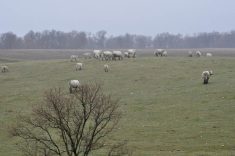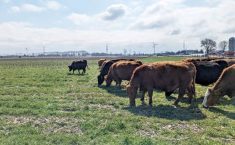Wet and wintery weather has set back many cattle producers across Manitoba, particularly in the southeast.
“I haven’t seen it this wet in 12 years,” said Grunthal Auction Mart manager Harold Unrau on October 11 as snow was falling across the province. “Everything is mud.”
Areas between Winnipeg and Brandon and south through the Red River Valley got the brunt of the snowstorm, according to Environment and Climate Change Canada. However, the southeast corner of the province has seen a deluge of rain from late summer into autumn, and is sitting at 135 to over 150 per cent of normal, according to Manitoba Agriculture data.

“It’s definitely hurting the market,” said Unrau. He said that feedlots don’t want to buy cattle because of muddy conditions, and because calves are at risk for getting sick.
Why it matters: Mother Nature has heaped insult on top of injury for Manitoba cattle producers, in the form of torrential rain and wet snow following a drought over the summer. It’s making a bad situation all the worse.
Those who are selling now are facing lower-than-average prices, Unrau said. People call him asking when it’s a good time to sell. He tells them “not right now, and I don’t know when it will be better.”
Read Also

Thunderstorms and straight-line winds
Straight-line winds in thunderstorms can cause as much damage as a tornado and are next on our weather school list exploring how and why severe summer weather forms.
Unrau said the pain is near-universal, with crops producers in his area unable to get what were pretty good crops off and silage growers struggle to take off feed from muddy fields, leaving huge ruts behind.
“It’s a whole new stress level for farmers,” he said. “It’s a disaster — way worse than a drought.”
The southeast has seen significant flooding in some areas, according to Manitoba Agriculture’s Oct. 15 crop report. Reports of bales under water and quarter sections of pasture and crops under a foot of water have been reported.
A beef producer near the community of Sundown, who asked his name not be published, showed the Manitoba Co-operator his second cut of hay, which was standing in several inches of water. Nearby, two rows of round bales also stood soaking up water.

The producer said he has about 80 cow-calf pairs stranded beyond flooded-out pastures and roads. One cow became separated from the herd and couldn’t be corralled. When the water rose higher, the animal died.
Much of the flood is due to poorly made and maintained drainage ditches, the producer said. He showed the Co-operator one large provincial drain that was built on a ridge not far from his farm. After persistent rain, much of the water can’t get to the drains and is flowing overland.
The producer said his farm would probably be short of feed because he hadn’t got his second cut of hay, and added that most feed that may have been available was sold to farmers in the Interlake. According to the Oct. 15 crop report, other producers are also short of hay.
Central-west
To the west, Manitou farmer Nancy Howatt said manure has piled up in her yard with nowhere to spread it because her crop hasn’t come off. Her silage was also still standing.
“I don’t care if I have to go hand-chop it,” she said on October 11. “We’ll do what we have to, to feed the cows.”

Howatt said it was too muddy to load the cattle in pasture to take them to auction, and access is limited because fields she’d usually drive across to access cattle are unharvested. She said she planned to use makeshift corral panels to load cattle in the yard.
“It went from one extreme to the other,” she said. The land was parched until August. Now there’s muck everywhere.
Howatt said it will be a long winter for some, who will be short of feed. She will be feeding a lot of oat straw with molasses, along with corn silage. Others haven’t been able to bale straw.
Peter Gilbraith, owner of Gilbraith Farm Services, said his customers were very anxious to get silage off before the snowstorm.
“Thirty people in one day — that’s impossible,” he said.
Gilbraith said he’s “way behind” but is confident he’ll get all his fields done.
Killarney Auction Mart postponed its Monday (Oct. 14) sale to that Thursday, said owner Alan Munroe on October 11. Munroe expected producers wouldn’t be able to get to cattle to haul them after the storm.
Munroe was less pessimistic about cattle sales than Unrau. He said producers would sell cattle to feedlots out west if local lots wouldn’t take them. He said the reason for delayed sales had more to do with mixed farmers focusing on a drawn-out harvest. He added that prices have been better than expected, though lower than a year ago.
He expected a good sale on Oct. 17, and said many producers had booked for the following Monday.

To the southwest, producers are questioning whether any further greenfeed or hay will be harvested, according to the Oct. 15 crop report. Silaging of corn will depend on snowmelt or ground freezing.
Cattle are mostly off pasture, the report added.
Interlake and northwest
In the northwest, producers are moving cattle off pasture and to wintering facilities, the crop report said. Very little to no supplemental harvest of additional winter feed is taking place due to wet field conditions. Corn silage harvest was progressing, with yields reported to be average.
Many producers are shipping calves, culling cows due to feed shortage, and challenging environmental conditions, the report said.
Despite recent rains, much of the Parkland region remains at below average of normal rainfall levels for the year.
Tim Clarke said the rain has perked up pastures west of the lakes, and has added yield to corn silage crops. The water is also recharging the depleted subsoil moisture. Manitoba Agriculture reported that producers in the Interlake were also seeing extended grazing time.
Clarke said he’s advising producers in his area to consider buying distiller dried grains (DDGs) as supplementary feed, as it can be bought and shipped to the Interlake and Parkland for a reasonable price.
Manitoba Agriculture reported that corn silaging was 60 to 70 per cent complete in the Interlake as of Oct. 15. Retrieving bales off wet fields has become a problem.
Forage availability continues to be a big concern for the region, the report said. There’s signs that more animals are going to market because of feed availability.







